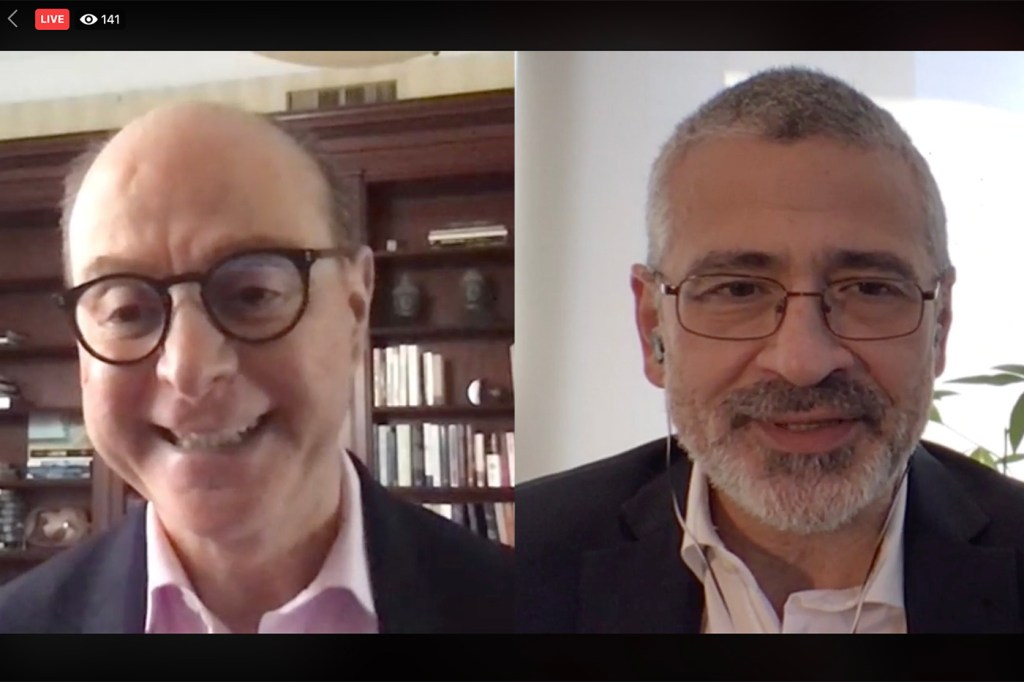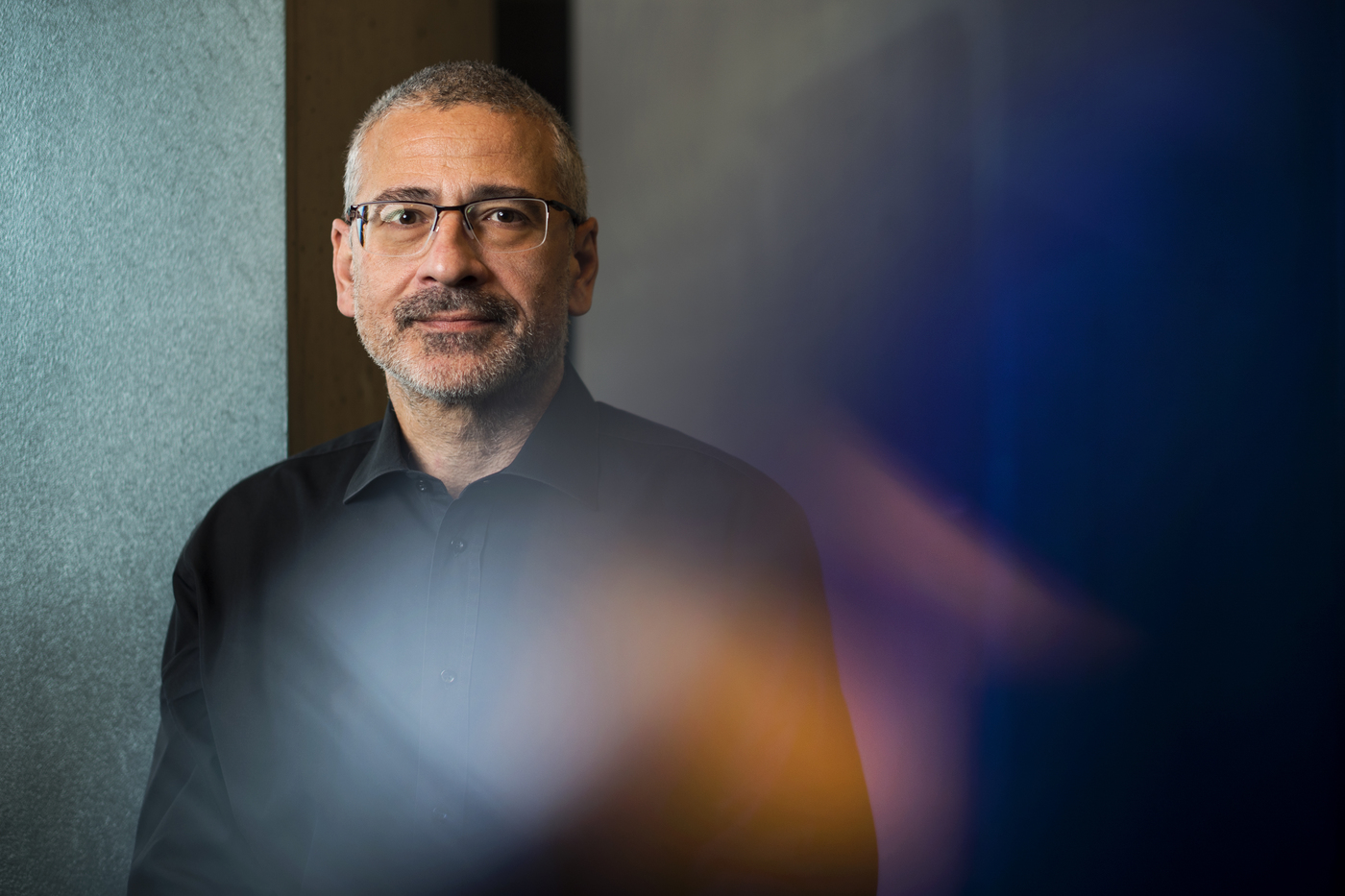How network science models can predict the next stages of the COVID-19 pandemic

In the United States and around the world, the conversation around COVID-19 is shifting toward reopening. But how do we know when it’s safe to reopen schools, businesses, communities, and countries? How do we make and follow a careful plan? And what will our new normal be when we get there?
Some of the best tools we have to make these decisions are epidemiological models, which predict how the disease will spread. Alessandro Vespignani, director of the Network Science Institute and Sternberg Family distinguished university professor of physics, computer sciences, and health science, is leading one of the major modeling efforts and his work is informing the decisions being made at Northeastern, and around the world.
The university is planning a phased reopening, bringing faculty and staff back first, with the intention of opening all campuses to students in the fall. Following guidance from public health officials regarding COVID-19, the university is considering a number of safety measures, such as large-scale testing of students, faculty, and staff, as well as contact tracing for those who test positive for the virus. The priority, says Joseph E. Aoun, president of Northeastern, is “maintaining the health and wellbeing of the Northeastern University community—and the world beyond our campuses.”
“We will have not only testing—everything is going to change,” Aoun says. “We are looking at the density in the classroom, the density in the dorms. We have secured an additional 2,000 beds in order to take care of the density issue. We have to look at our athletic events. We have to look at the density throughout the campus, the food courts, everything. It’s not going to be business as usual.”
“We are a community,” Aoun says. “And in a community we are all responsible for each other.”
In relying on Vespignani’s research, the university is tapping into the knowledge of a team that has forecasted outbreaks of Ebola, Zika, and the flu, among others. Vespignani’s team was selected as one of five groups to advise the White House on COVID-19, and their work is being used by public health officials and policymakers across the globe.
The key to Vespignani’s work, and what makes it different from traditional modeling methods, is including the human element. His model accounts for the incubation period of the disease, how contagious it is, and the method of transmission. But it also incorporates factors that influence human behavior, such as transportation, social interactions, and the availability of medical resources in different areas.
All this information feeds back into the model to predict the likely spread of the disease and, most importantly, how specific policies could help bring it under control.
On Thursday, Aoun joined Vespignani for a conversation on Facebook Live to discuss where we are now in the COVID-19 crisis, where we’re headed, and what policymakers can do to prepare for the next pandemic.
So Alex, could you tell us a little bit about where we are today? What’s your assessment? Let’s start with the United States and then look at the world as a whole.
Well, the situation is complex and we are still in the midst of the storm, in a sense… A lot of discussion in the United States is about reopening. Unfortunately, the signals are conflicted. We see that overall, nationally, there is an improvement and the number of deaths that we record is plateauing… but in some of the states, unfortunately, we see the opposite trend and actually we see an increasing direction for fatalities.
Also, some states have started to reopen part of the businesses, and some others are not, and so the situation is quite heterogeneous. It will be crucial in the next few weeks to see what’s going on and to see what is coming at us.
In the rest of the world, the situation is even more complex. There are places like South America where the epidemic is gaining steam now; Africa has started to report cases and the number of cases is increasing, although they will have, probably, the big wave a little later; and the last thing that is worth mentioning is that in the Far East, in Japan, South Korea, Hong Kong, Singapore, China, where the epidemic went down because of the very aggressive social distancing that they did, when they started to reopen, they started to have, again, cases.
And so this is a warning for us that we need to be very careful in the way that we strategize about reopening our societies.
Today, a scientist at the World Health Organization said that COVID-19 is going to be with us for a long time, and society will get used to it, so don’t expect it to disappear in a year or two years. What do you think of that? Are we going to live with COVID-19 for many years to come?
There are human coronaviruses that have been circulating in the population every year. They are seasonal viruses. What will happen is that, likely, this coronavirus might become endemic and be widespread in the population. But it will be a completely different story down the road—I don’t want to send the wrong message to people and have them think that, for the next five years, we’ll have to shelter in place and be terrified of this virus.

Alessandro Vespignani is director of the Network Science Institute and Sternberg Family distinguished university professor of physics, computer sciences, and health science at Northeastern. Photo by Adam Glanzman/Northeastern University
This virus, now, is very, very dangerous because the entire population is susceptible. And so when it starts spreading in the population, it generates a huge wave—it’s a kind of tsunami of cases that is going to overwhelm healthcare systems. This is why we are very careful in doing social distancing. We want every person that gets sick to get the proper care and especially intensive care if needed.
When a large fraction of the population will have been exposed to the virus at least once, then the virus will circulate at much lower levels. We will have to be careful, because it’s still a serious disease, especially for elderly people or people with pre-existing conditions and co-morbidities, but the impact will be extremely different.
The other thing is that, in the next few months, I’m pretty sure that we will develop therapeutics and so we will have drugs, we will have a way to treat the cases… And the final weapon that we have is a vaccine—we all hope that within one year we will be able to deliver a vaccine in large quantities to the world population.
South Korea, New Zealand, and Sweden have each responded differently to the pandemic. Could you explain to us those different approaches? Which one is working? Which one has to be refined? What are the issues that they are facing?
Hong Kong, Singapore, South Korea, they went for an approach that is very aggressive in mitigating the virus by doing extensive testing, and tracing, and treatment. And that means that you really test a lot of people. You go and try to find and trace all the contacts of them, you do preemptive isolation of those cases. And they were able to keep cases at a very low level. That is very time consuming, and needs a lot of resources and effort, and I think is the way we’re going to spare lives.
The Swedish approach is to say, ‘Well, we try to mitigate, as much as we can, the epidemic, but we let it run through the population.’
What they want to do is to build what we call ‘herd immunity.’ So the disease, the virus, will fade away, after a large fraction of the population has been infected, because it will not find hosts to infect. And that is what obviously leads to a decrease of cases, but, unfortunately, this is based on, in a sense, sacrificing some part of the population that will develop complications.
Additionally, since you have to protect the healthcare system, what happens is that you have to put strict rules on who really is allowed to get critical care and who is not. And so these are draconian decisions that again, are made about people’s lives, unfortunately.
There is another approach, and that is to try to balance those two in a way… We try to crush the virus as much as we can, bring it down, and make an effort for five, six months of tracing and treatment and testing, and then get finally to the vaccine. Again, plenty of resources have to be devoted to this approach, but it can really spare a large number of lives.
One of your studies discovered that the coronavirus was circulating in the United States, in other countries, much earlier than we thought. Why didn’t we spot COVID-19 early on? What did you know that we didn’t?
Well, what we know is the numerical models and what, at that time, was the situation in China. It was possible to generate large-scale simulations of the trajectory of the epidemic across the world, as you would do for the trajectory of a hurricane. And you have uncertainty, because you are looking at the future, but you see that the epidemic was undetected in several places in the world. So we were estimating hundreds of cases of undetected infections.
This is a disease that, unfortunately, has asymptomatic cases, subclinical cases. They are almost impossible to detect. And at that time, no country in the world had the capabilities to do large-scale testing. And so the guidelines were to test people based on travel history. So if you were arriving from China and you were sick, you were tested. Otherwise, you were not.
That, unfortunately, let the epidemic spread in an—I always use this term—invisible way in January and February, until March, when the evidence was there, because you started to see people dying in hospitals and cases emerging in clusters. And so the testing at that point was ramped up in order to detect more cases. And this is where we are now.
The model, at that point, was a way to look at the invisible. The model is able to look at the invisible, because in tracking individuals traveling across the world, it tracks the invisible infections.
The modeling community knew that, and many agencies knew that. But then you have to put yourself in the shoes of policymakers… It’s very difficult to make a decision like shutting down a country, stopping economic activities, based on something that is just invisible, something that is in a numerical model.
Meteorologists have one big advantage with respect to us: They always have a big, nice satellite photo of the hurricane out there at sea. And so you know that there is a danger out there. When we talk to policymakers, we have these models, we have those numbers, but there is no picture or photo that you can add to them. And that makes a difference.
I hope that this experience was a learning experience for all of us, including the policymakers, in the sense that the next time we’ll try not to repeat those errors.
What are the lessons learned? For the next time, what do we need to keep in mind? What do we need to activate earlier?
I think this is really an example of how, in an interconnected world like ours, we are all in the same boat. The pandemic, now, is everywhere in the world.
We need to have infrastructure in place. We have national weather services, no? Why don’t we have a national pandemic forecasting observatory? Why don’t we have that in every country in the world? Why don’t we have the capacity to move resources against the pandemic in a way that is almost automatic?
If you think about the last 20 years, we had one flu pandemic in 2009, we had SARS, we had MERS, we had Zika, and we have, now, COVID. So these are not rare events. We were lucky in previous instances. This time, we really have seen how deadly and disruptive they can be. So we need to be better prepared.
What kind of data do you use in your models?
What we need, first of all, is data about the world. We need the population data, census data, we need mobility data. That goes from airline data that we can get from official databases in real time, to commuting patterns and human mobility that we can track from mobile devices.
All that tells about the whereabouts of us, because we are the carriers of an epidemic.
The other thing that we need is data on the disease. Each disease is a story of its own. And this was one of the problems with COVID—we didn’t have all the data initially about the disease because it was the first time it appeared in the world. So what is the incubation time? What is the infectiousness? What is the ratio of asymptomatic transmissions versus symptomatic transmissions? All things that we have learned in those months, and some of them are still, unfortunately, uncertain.
Which key metrics should we be observing, and how do your teams keep up with the constant changing environment here?
You know, I was saying that, with respect to meteorology, we were unlucky because we don’t have the photo of the hurricane. But we are lucky in another sense, because the trajectory of the hurricane is unchangeable… With a pandemic, we can change its trajectory.
What we do as humans makes an impact on the trajectory of pandemic, and this is what we have to factor into the model. This is the changing environment: policies, what the governor of a state does, what a president of a country does, what we do as single individuals. Do we stay home? Do we avoid contact with other people? Are we aware of the dangers of a disease? Do we wear masks and gloves?
All that is something that is to be factored in the model. And this is what we do… The 24/7 work that we are doing is to monitor those changes, monitor those policies, and bring them into the model, so that we can change the model constantly.
In your modeling of Ebola, how did it inform the COVID model? And how is the pandemic affecting how modeling is going to be approached and used in the future?
Ebola was one way to learn a lot about models—how to improve models, what are the limits of modeling? These are still things that we are learning now. What is our time horizon? Joseph, if I tell you what the weather will be in three months, you will laugh at me and you know that I am a charlatan. So if I tell you what the evolution of this epidemic will be in two years, you don’t have to believe me. We need to understand better, what is the level of uncertainty the farther you push the time horizon.
In a sense, some models have been criticized because they were readjusting themselves to new evidence, but this is normal at this stage. The world is changing and, as we were discussing before, policies are changing, and what we know about the virus is changing, and so we need to recalibrate models.
There are two ways of working for us. One is what I call the ‘wartime,’ like now. Everything you do is on a cycle of 24 hours. What do you do now, you don’t have time to refine, and perhaps change the day after.
And then there will be the time for research, when we will go into ‘peacetime.’ Then we will develop new tools. We will learn from this lesson and produce better infrastructure for the next time.
Why is network science well suited for disease modeling?
Well, the virus is spreading on a network and the network is our invisible connections—when we talk, when we are in the same room, when we share space in our household.
This is the network of the contact patterns that keep this social fabric together, and the virus needs that social fabric. And then there is another, larger network: how we move, how we go from one place to another. You take a plane from Boston and go to Paris—this is a network of flow of people.
A network is crucial to describe how infectious disease spreads, and this is what we do. This is what gives us the algorithms and the methodologies to face the analysis and forecast of the spreading of diseases.
This story has been abridged. The full interview can be watched here.
For media inquiries, please contact media@northeastern.edu.




